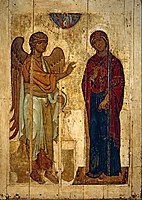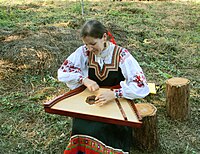Novgorod Oblast
| Novgorod Oblast Новгородская область(Russian) | |||
|---|---|---|---|
| —Oblast— | |||
| |||
Coordinates:58°26′N32°23′E/ 58.433°N 32.383°E | |||
| Political status | |||
| Country | Russia | ||
| Federal district | Northwestern[1] | ||
| Economic region | Northwestern[2] | ||
| Administrative center | Veliky Novgorod | ||
| Government(as of March 2014) | |||
| •Governor[4] | Andrey Nikitin[3] | ||
| • Legislature | Oblast Duma[5] | ||
| Statistics | |||
| Area(as of the 2002 Census)[6] | |||
| • Total | 55,300 km2(21,400 sq mi) | ||
| Area rank | 48th | ||
| Population(2010 Census)[7] | |||
| • Total | 634,111 | ||
| • Rank | 69th | ||
| • Density[8] | 11.47/km2(29.7/sq mi) | ||
| • Urban | 70.6% | ||
| • Rural | 29.4% | ||
| Population(2013 est.) | |||
| • Total | 625,855[9] | ||
| Time zone(s) | MSK(UTC+04:00) | ||
| ISO 3166-2 | RU-NGR | ||
| License plates | 53 | ||
| Official languages | Russian[10] | ||
| [novreg.ruOfficial website] | |||
Novgorod Oblast(Russian:Новгоро́дская о́бласть,Novgorodskaya oblast) is afederal subjectofRussia.Specifically, it is anoblast.Itsadministrative center(capital city) is thecityofVeliky Novgorod.Some of the oldestRussian cities,including Veliky Novgorod andStaraya Russa,are in the oblast. Thehistoric monuments of Veliky Novgorod and surroundingshave been made aUNESCOWorld Heritage Site.Population:634,111 (2010 Census).[7]
Geography
[change|change source]
Novgorod OblastbordersLeningrad Oblastin the north and in the northwest,Vologda Oblastin the east,Tver Oblastin the southeast and in the south, andPskov Oblastin the southwest.
Lake Ilmen
[change|change source]In the center of the oblast isLake Ilmen.Lake Ilmen is one of the largest lakes in Central Russia. The majortributariesof Lake Ilmen are theMsta,theLovat,thePola,thePolist,and theShelon.The onlyoutflowof the lake is theVolkhov,a major tributary ofLake Ladoga.
Protected areas
[change|change source]Two areas in Novgorod Oblast have been madeprotected natural areasof federalsignificance.[11]These areValdaysky National Parkin the southeast of the oblast andRdeysky Nature Reservein the southwest of the oblast, which protects thePolist-Lovat Swamp Systemand is next toPolistovsky Nature ReserveinPskov Oblast.
History
[change|change source]
Novgorod is one of the oldest centers ofRussiancivilization.It was on the historicaltrade route from the Varangians to the Greeks.This route followed the Volkhov upstream to Lake Ilmen and then followed the course of the Lovat before reaching theDnieper.In 1136, Novgorod became the center of theNovgorod Republic.The Novgorod Republic included the major part of what is today northwestern Russia. Novgorod was part of theHanseatic League.It was one of the few areas ofRusnot affected by theMongol invasions.It was also a major cultural center.
Towards the end of the15th century,Novgorod was defeated by the army ofIvan III,theprinceofMoscow.It was included into theGrand Duchy of Moscow.In 1560,Ivan the Terrible,fearingtreason,sent his army tosackthe city. This event was known as theMassacre of Novgorod.It had terribleconsequencesfor the city, which lost the majority of its population and never recovered. Additionally, Novgorod waslootedby the Swedish army in the beginning of the17th century,during theTime of Troubles.
19th century
[change|change source]Before the19th century,the areas around Novgorod were much better developed than the areas which are currently in the center and the east of the oblast. In 1851,Moscow – Saint Petersburg Railwayopened. It was the first long-distancerailwayin Russia. It went around Novgorod as it was built on a straight line between Moscow and Saint Petersburg. The railwayconstructionlead to the development of the nearby areas and eventually to creation of newtownssuch asMalaya Vishera,Okulovka,andChudovo.
20th century
[change|change source]On August 1, 1927 the governorates of theRussian Empirewere removed. The territory of present-day Novgorod Oblast merged into newly createdLeningrad Oblast.[12]German troopsoccupiedthe area between autumn of 1941 and spring of 1944 duringWorld War II.After itsliberationon 5 July 1944, Novgorod Oblast was created.
In 1999, the city of Novgorod was renamed Veliky Novgorod.
Administrative divisions
[change|change source]The oblast isadministrativelydivided intothree cities and towns under the oblast's jurisdiction(Veliky Novgorod,Borovichi,andStaraya Russa) and twenty-onedistricts.Another seven towns (Chudovo,Kholm,Malaya Vishera,Okulovka,Pestovo,Soltsy,andValday) have the status of the towns of district significance.[13]
Demographics
[change|change source]Population:634,111 (2010 Census),[14]down from 694,355 recorded by the2002 Census,[15]and further down from about 753,054 recorded in the1989 Census.[16]
Novgorod Oblast has the lowest population of any oblast in theEuropean part of Russia.One of the reasons for the low population is that the area took large losses duringWorld War II.The population is 70.6%urban.[14]
Ethnic groups
[change|change source]In the 2010 Census, these were the largestethnicitiesin Novgorod Oblast: 560,280Russians(95.1%); 7,025Ukrainians(1.2%); 3,598Romani(0.6%); 3,438Belarusians(0.6%); 15,054 others.[14]
Gallery
[change|change source]-
Ustyug Annunciation, a Novgorod icon from the 12th century
-
Church of the Transfiguration on Ilyina Street, Veliky Novgorod
-
TheGusliinstrument was first recorded in 12th century in Novgordian Rus'.
-
The birch bark manuscript No. 202 written byOnfim,unearthed in Novgorod
References
[change|change source]- ↑Президент Российской Федерации. Указ №849 от 13 мая 2000 г. «О полномочном представителе Президента Российской Федерации в федеральном округе». Вступил в силу 13 мая 2000 г. Опубликован: "Собрание законодательства РФ", №20, ст. 2112, 15 мая 2000 г.(President of the Russian Federation. Decree #849 of May 13, 2000On the Plenipotentiary Representative of the President of the Russian Federation in a Federal District.Effective as of May 13, 2000.).
- ↑Госстандарт Российской Федерации. №ОК 024-95 27 декабря 1995 г. «Общероссийский классификатор экономических регионов. 2. Экономические районы», в ред. Изменения №5/2001 ОКЭР.(Gosstandartof the Russian Federation. #OK 024-95 December 27, 1995Russian Classification of Economic Regions. 2. Economic Regions,as amended by the Amendment #5/2001 OKER. ).
- ↑Official website of Novgorod Oblast.Andrey Sergeyevich Nikitin, Acting Governor of Novgorod OblastArchived2018-03-27 at theWayback Machine(in Russian)
- ↑Charter of Novgorod Oblast, Article 42
- ↑Charter of Novgorod Oblast, Article 16
- ↑Федеральная служба государственной статистики (Federal State Statistics Service) (2004-05-21)."Территория, число районов, населённых пунктов и сельских администраций по субъектам Российской Федерации (Territory, Number of Districts, Inhabited Localities, and Rural Administration by Federal Subjects of the Russian Federation) ".Всероссийская перепись населения 2002 года (All-Russia Population Census of 2002)(in Russian). Federal State Statistics Service.Retrieved2011-11-01.
- ↑7.07.1Всероссийская перепись населения 2010 года. Том 1[2010 All-Russian Population Census, vol. 1].Всероссийская перепись населения 2010 года (2010 All-Russia Population Census)(in Russian).Federal State Statistics Service.2011.RetrievedJune 29,2012.
- ↑The density value was calculated by dividing the population reported by the 2010 Census by the area shown in the "Area" field. Please note that this value may not be accurate as the area specified in the infobox is not necessarily reported for the same year as the population.
- ↑Novgorod Oblast Territorial Branch of theFederal State Statistics Service.Численность мужчин и женщин(PDF)(in Russian). Archived fromthe original(PDF)on October 19, 2017.RetrievedMarch 26,2014.
- ↑Official throughout the Russian Federation according to Article 68.1 of theConstitution of Russia.
- ↑ООПТ Северо-Западного округа(in Russian). Особо охраняемые природные территории России.Retrieved1 March2011.
- ↑Снытко, О.В.; et al. (2009). С.Д. Трифонов; Т.Б. Чуйкова; Л.В. Федина; А.Э. Дубоносова (eds.).Административно-территориальное деление Новгородской губернии и области 1727-1995 гг. Справочник(PDF)(in Russian). Saint Petersburg. p. 85.Retrieved2 March2011.
{{cite book}}:CS1 maint: location missing publisher (link) - ↑Государственный комитет Российской Федерации по статистике. Комитет Российской Федерации по стандартизации, метрологии и сертификации. №ОК 019-95 1 января 1997 г. «Общероссийский классификатор объектов административно-территориального деления. Код 49», в ред. изменения №278/2015 от 1 января 2016 г..(State Statistics Committee of the Russian Federation. Committee of the Russian Federation on Standardization, Metrology, and Certification. #OK 019-95 January 1, 1997Russian Classification of Objects of Administrative Division (OKATO). Code 49,as amended by the Amendment #278/2015 of January 1, 2016. ).
- ↑14.014.114.2Всероссийская перепись населения 2010 года. Том 1[2010 All-Russian Population Census, vol. 1].Всероссийская перепись населения 2010 года (2010 All-Russia Population Census)(in Russian).Federal State Statistics Service.2011.RetrievedJune 29,2012.
- ↑Численность населения России, субъектов Российской Федерации в составе федеральных округов, районов, городских поселений, сельских населённых пунктов – районных центров и сельских населённых пунктов с населением 3 тысячи и более человек[Population of Russia, its federal districts, federal subjects, districts, urban localities, rural localities—administrative centers, and rural localities with population of over 3,000].Всероссийская перепись населения 2002 года(All-Russia Population Census of 2002)(in Russian).Federal State Statistics Service.May 21, 2004.Retrieved9 Feb2012.
- ↑Demoscope Weekly(1989).Всесоюзная перепись населения 1989 г. Численность наличного населения союзных и автономных республик, автономных областей и округов, краёв, областей, районов, городских поселений и сёл-райцентров.[All Union Population Census of 1989. Present population of union and autonomous republics, autonomous oblasts and okrugs, krais, oblasts, districts, urban settlements, and villages serving as district administrative centers].Всесоюзная перепись населения 1989 года(All-Union Population Census of 1989)(in Russian). Institute of Demographics of the State University—Higher School of Economics.Retrieved9 Feb2012.
- ↑"On the Trail of the Onion".Russia Experience.2011-02-11. Archived fromthe originalon 2018-08-03.Retrieved2019-03-18.
Other websites
[change|change source]- Kropotkin, Peter Alexeivitch;Bealby, John Thomas (1911)..Encyclopædia Britannica.Vol. 19 (11th ed.). p. 839.
- Information for tourists(in Russian)
- Central Eurasian Information Resource: Images of Novgorod Oblast—University of Washington Digital Collections







![The Saint Sophia Cathedral of Novgorod was one of the first churches which introduced Onion domes[17]](https://upload.wikimedia.org/wikipedia/commons/thumb/0/02/Saint_Sophia_Cathedral_in_Novgorod_%28cropped%29.jpg/200px-Saint_Sophia_Cathedral_in_Novgorod_%28cropped%29.jpg)
